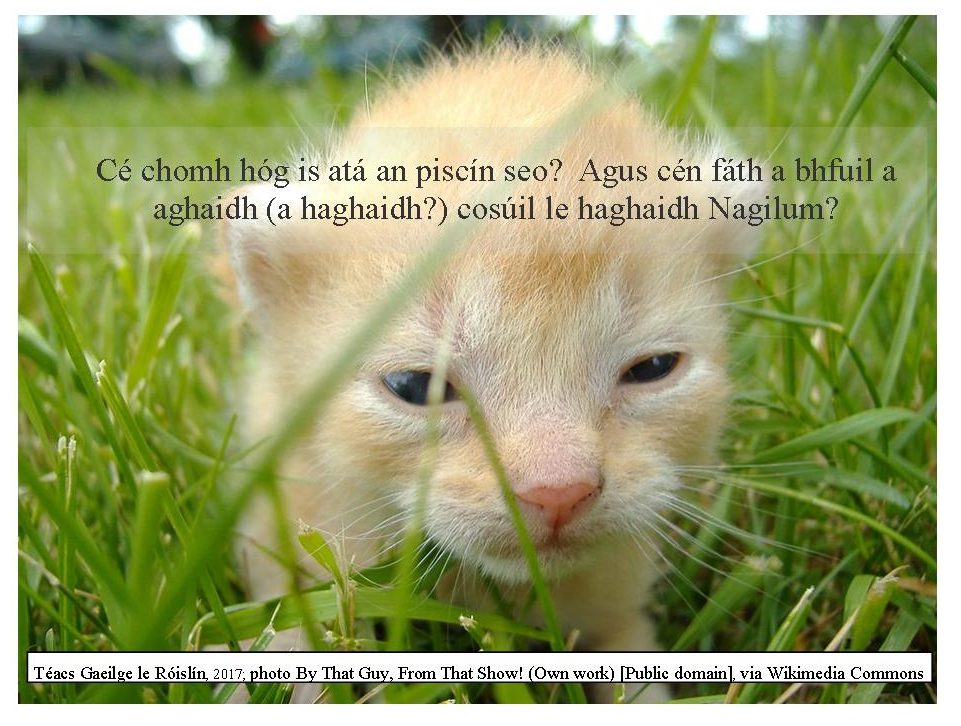An bhfuil peata agat? Talking about Pets in Irish: Piscíní (Kittens) Posted by róislín on Jun 16, 2017 in Irish Language
(le Róislín)
Bhuel, we’ve just discussed coiníní as peataí in our sraith nua (faoi pheataí), so let’s go now with an even more popular pet, piscíní, and we’ll look more later at “cait,” which have been covered in some previous posts.
As you can see in the picture above, we have an image of a ridiculously cute kitten, with its eyes fairly recently opened. Although we may never know the exact age of the kitten on the day the “grianghraf” was taken, we could run a little “comórtas” to guess the kitten’s age (aois an phiscín). Since I assume most people who will participate are probably pretty keen observers of kittens, I’ll assume their answers will be fairly well informed. After a few days, we’ll announce “buaiteoirí an chomórtais.” And there will be an extra benefit of running this comórtas — practicing how to say “days old,” “weeks old,” and “months old” in Irish.
Answers could be in sentences like the following:
Tá an piscín lá amháin d’aois (i bhfad ró-óg, I know, but I wanted to cover the numbers thoroughly)
Tá an piscín dhá (trí, ceithre, cúig, sé, seacht, ocht, naoi, deich) lá d’aois.
If you want to express the number of days in teens, you could have “___ lá déag d’aois” (___ days-teen of age), preceded by the following: aon, dhá, trí, ceithre, cúig, sé, seacht, ocht, naoi.
Twenty days and thirty days would be: fiche lá d’aois and tríocha lá d’aois.
For months: Tá an piscín mí amháin d’aois (one month old). For 2 to 6 months, we’d have: dhá mhí, trí mhí, ceithre mhí, cúig mhí, sé mhí.
I really doubt this kitten is anywhere near seven months old, but if we did want to say anything from seven to ten months old, we’d drop that extra “h” we had added above: seacht mí, ocht mí, naoi mí, deich mí.
Do bharúil? Cén aois é (í)? Mí nó níos lú?
If you want to express another age, not modeled above, please feel free to give it a whirl in the comments, or just ask, for example, “Cén Ghaeilge atá ar ’22 days’“? Or “Conas a déarfá ’22 days’ i nGaeilge?”
And now for the word “piscín” itself, and its compatriots “puisín” and “pisín” (not used as often, in my experience).
an piscín, the kitten
an phiscín, of the kitten (súile geala gleoite agus sróinín beag gleoite an phiscín róghleoite, the cute bright eyes and the cute little nose of the too-cute kitten)
na piscíní, the kittens
na bpiscíní, of the kittens (súile geala gleoite agus sróiníní beaga gleoite na bpiscíní róghleoite)
The word “puisín” has the same basic form and structure (i.e. it’s also 4th-declension, with the “-ín” ending): an puisín, ainm an phuisín, na puisíní, ainmneacha na bpuisíní
And the same holds for “pisín“: an pisín, an phisín, na pisíní, na bpisíní
So that’s the basics for kittens. An bhfuil piscín agat? Má tá, inis dúinn, más mian leat, cén sórt é nó í? An aois, an t-ainm, an dath, uigeacht an fhionnaidh, tréithe gleoite eile an phiscín, srl.)
And to wrap up we’ll consider a couple “non-piscín” kitten terms and one famous, otherworldly, preternatural, kittenish face!
For “kitty” in the sense of “an amount of money,” the Irish is simply “carnán” (little heap), related to the English word “cairn,” which comes from Irish originally.
For the phrase “to have kittens,” in the sense of “to have a cow” (i.e. to be upset), a typical Irish expression is “dul le báiní“(lit. “go with franticness / fury / wildness / frenzy).
And finally, remember the character “Nagilum” (Star Trek, natch), whose face looked an awful lot like a kitten’s? So far, I’ve found nothing in the background literature to suggest that the face of Nagilum was actually inspired by a kitten, but it sure looks it to me. Do bharúil? You can see it at: http://memory-alpha.wikia.com/wiki/Nagilum Nach bhfuil cuma phiscín ar a aghaidh? I’m assuming Nagilum is male, so we’ll say “a aghaidh” (not “a haghaidh,” which would be the feminine form). Actually, Nagilum may not have any “inscne” at all, since he (?) isn’t normally corporeal, but that dilemma will have to be discussed another day. For the caption for the kitten above, I said “a aghaidh (a haghaidh)” since I can’t really tell if it’s male or female — the “h” marks the difference between “his” and “her.”
I did, though, inadvertently discover a slight Irish connection to the series, since the character Nagilum’s name is the reverse of the Irish surname Mulligan, minus an “L”. Why Mulligan? The Irish-American actor Richard Mulligan was originally considered for the part although he didn’t end up getting the role, which went to Earl Boen. I guess “Neob” didn’t cut the mustard, even though it is intriguing-looking.
Anyway, I hope you enjoyed that bit of kitten talk, grammar practice with numbers, and some vocabulary meowanderings! SGF — Róislín
For a follow-up to this topic, please see: Aghaidheanna Cat (Faces of Cats) — Their Main Features in Irish Posted by róislín on Jun 25, 2017 in Irish Language

Build vocabulary, practice pronunciation, and more with Transparent Language Online. Available anytime, anywhere, on any device.





Leave a comment: